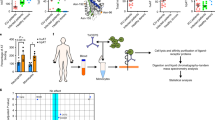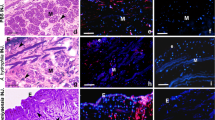Abstract
Antithrombin (AT), which is mainly synthesized in the liver, is an acute-phase plasma protein in mammalian species. Here, we demonstrated that sheep anti-human AT antibody cross-reacted with the humoral fluids in amphioxus Branchiostoma belcheri tsingtauense as well as human serum. The concentration of AT in the humoral fluids in amphioxus decreased slightly at first and then increased after the acute challenge with lipopolysaccharide, while the level of total proteins remained unchanged. These suggest the presence of the same acute-phase response pattern in amphioxus, as observed in some mammalian species. Immunohistochemically, AT was localized in the hepatic diverticulum. It is clear that the hepatic diverticulum in amphioxus is homologous to the vertebrate liver with respect to AT synthesis. This lends support to the hypothesis originally suggested by Müller that the vertebrate liver evolved from the hepatic diverticulum of an amphioxus-like ancestor during early chordate evolution.



Similar content being viewed by others
References
Abildgaard U (1979) A review of anti-thrombin III. In: Collen D, Wiman B, Verstaete M (eds) The physiological inhibitors of coagulation and fibrinolysis. Elsevier/North-Holland Biochemical, Amsterdam, pp 19–29
Andersen Ø, Flengsrud R, Norberg K, Salte R (2000) Salmon antithrombin has only three carbohydrate side chains, and shows functional similarities to human β-antithrombin. Eur J Biochem 267:1651–1657
Bock SC, Wion KL, Vehar GA, Lawn RM (1982) Cloning and expression of the cDNA for human antithrombin III. Nucleic Acids Res 10:8113–8125
Chan TK, Chan V (1981) Antithrombin III, the major modulator of intravascular coagulation, is synthesized by human endothelial cells. Thromb Haemost 46:504–506
Cucuianu M, Plesca L, Bodizs G, Colhon D, Brudasca I (1996) Acute phase reaction and the hemostatic balance. Rom J Intern Med 34(1–2):13–18
Doolittle RF (1993) The evolution of vertebrate blood coagulation: a case of Yin and Yang. Throm Haemost 70(1):24–28
Fair DS, Bahnakk BR (1984) Human hepatoma cells secrete single chain factor X, prothrombin, and antithrombin III. Blood 64:194–204
Frost CL, Naudé RJ, Muramoto K (2002) Ostrich antithrombin III: kinetics and mechanism of inhibition of ostrich thrombin. Int J Biochem Cell Biol 34:1164–1171
Hammar JA (1898) Zur Kenntnis der Leberentwicklung bei Amphioxus. Anat Anz 14:602–606
Hashimoto C, Kim DR, Weiss LA, Miller JW, Morisato D (2003) Spatial regulation of developmental signaling by a serpin. Dev Cell 5:945–950
Holland ND, Venkatesh TV, Holland LZ, Jacobs DK, Bodmer R (2003) AmphiNk2-tin, an amphioxus homeobox gene expressed in myocardial progenitors: insights into evolution of vertebrate heart. Dev Biol 255:128–137
Holland LZ, Laudet V, Schubert M (2004) The chordate amphioxus: an emerging model organism for developmental biology. Cell Mol Life Sci 61:2290–2308
Jordan RE (1983) Antithrombin in vertebrate species: conservation of the heparin-dependent anticoagulant mechanism. Arch Biochem Biophys 227(2):587–595
Koide T (1979) Isolation and characterization of antithrombin III from human, porcine and rabbit plasma, and rat serum. J Biochem 86:1841–1850
Koide T, Ohta Y, Odani S, Ono T (1982) Chicken antithrombin. Isolation, characterisation and comparison with mammalian antithrombins and chicken ovalbumin. J Biochem (Tokyo) 91(4):1223–1229
Koj A (1985) Definition and classification of acute-phase proteins. In: Gordon AH, Koj A (eds) The acute response to injury and infection. Elsevier, Amsterdam, pp 139–144
Koj A, Regoeczi E (1978) Effect of experimental inflammation on the synthesis and distribution of antithrombin III and α1-antitrypin. Br J Exp Pathol 59:473–481
Kourteva Y, Schapira M, Patston PA (1995) The effect of sex and age on antithrombin biosynthesis in the rat. Thromb Res 78(6):521–529
Kowalevski A (1877) Weitere Studien über die Entwickelungsgeschichte des Amphioxus lanceolatus, nebst einem Beitrage zur Homologie des Nervensystem der Würmer und Wirbelthiere. Arch Mikrosk Anat 13:181–204 (plates XV–XVI)
Kurachi K, Schmer G, Hermodson MA, Teller DC, Davie EW (1976) Characterisation of human, bovine and horse antithrombin III. Biochemistry 15:368–372
Laemmli UK (1970) Cleavage of structural proteins during the assembly of the head of bacteriophage T4. Nature 227:680–685
Mak P, Enghild JJ, Dubin A (1996) Hamster antithrombin III: purification, characterization and acute phase response. Comp Biochem Physiol B Biochem Mol Biol 115(1):135–141
Mejdoub H, Le Ret M, Boulanger Y, Maman M, Choay J, Reinbolt J (1991) The complete amino acid sequence of bovine antithrombin III. J Protein Chem 10:205–201
Müller J (1844) Ueber den Bau und die Lebenserscheinungen des Branchiostoma lubricum Costa, Amphioxus lanceolatus. Yarrell Abh K Preuss Akad Wiss Berl 1844:79–116
Nakayama Y, Kojima T, Takaji A (2000) Cloning and characterization of the murine antithrombin gene. Thromb Res 100:179–183
Niessen RW, Sturk A, Hordijk PL, Michiels F, Peters M (1992) Sequence characterization of sheep cDNA for antithrombin III. Biochim Biophys Acta 1171:207–210
Niessen RW, Lamping RJ, Jansen PM, Prins MH, Peters M, Taylor FB Jr, de Vijlder JJ, ten Cate JW, Hack CE, Sturk A (1997) Antithrombin acts as a negative acute phase protein as established with studies on HepG2 cells and in baboons. Thromb Haemost 78(3):1088–1092
Olson ST, Bjork I (1994) Regulation of thrombin activity by antithrombin and heparin. Semin Thromb Hemost 20:373–409
Pang QX, Zhang SC, Wang CF, Shi XD, Sun YN (2004) Presence of prophenoloxidase in the humoral fluid of amphioxus Branchiostoma belcheri tsingtauense. Fish Shellfish Immunol 17:477–487
Pang QX, Zhang SC, Shi XD, Su F, Wu D (2005) Purification and characterization of prophenoloxidase from amphioxus Branchiostoma belcheri tsingtauense. Fish Shellfish Immunol 19:139–148
Rähr H (1979) The circulatory system of amphioxus (Branchiostoma lanceolatum [Pallas]). A light-microscope investigation based on intravascular injection technique. Acta Zool (Stockh) 60:1–18
Rosenberg RD (1987) The heparin–antithrobin system: a natural anticoagulant mechanism. In: Colman RW, Hirsh J, Marder VJ, Salzman EW (eds) Hemostasis and thrombosis. Lippincott, Philadelphia, pp 1373–1392
Ruppert EE (1997) Hemichordata, chaetognatha, and the invertebrate chordates. In: Harrison FW, Ruppert EE (eds) Microscopic anatomy of invertebrates, vol 15. Wiley-Liss, New York, pp 349–504
Salte R, Norberg K, Ødegaard OR (1995) Some functional properties of teleost antithrombin. Thromb Res 80(3):193–200
Sheffield WP, Brothers AB, Wells MI, Hatton MW, Clarke BJ, Blajchman MA (1992) Molecular cloning and expression of rabbit antithrombin III. Blood 79:2330–2339
Tokunaga F, Goto T, Wabayashi S, Koid T (1994) Amino acid sequence of porcine antithrombin III. J Biochem 116:1164–1170
Wang CF, Zhang SC, Lu Y, Xu TT (2002) Presence and induction by bacteria of D-galactoside-specific lectins in the humoral fluids of amphioxus Branchiostoma belcheri tsingtaunese. Inflammopharmacology 9:241–248
Wang Y, Zhang S, Liu Z, Li H, Wang L (2005) Characterization and expression of AmphiCL encoding cathepsin L proteinase from amphioxus Branchiostoma belcheri tsingtauense. Mar Biotechnol, March 24, Epub ahead of print
Welsch U (1975) The fine structure of the pharynx, cyrtopodocytes and digestive caecum of Amphioxus (Branchiostoma lanceolatum). Symp Zool Soc Lond 36:17–41
Wu JK, Sheffield WP, Blajchman MA (1992) Molecular cloning and cell free expression of mouse antithrombin III. Thromb Haemost 68:291–296
Zhang SC, Wang CF, Wang YJ, Wei R, Guo GH, Ju H (2003) Presence and characterization of complement-like activity in the amphioxus Branchiostoma belcheri tsingtauense. Zool Sci 20:1207–1214
Author information
Authors and Affiliations
Corresponding author
Additional information
This work was supported by the Natural Science Foundation of China (NSFC; 30470203) and the Ministry of Science and Technology (MOST) of China.
Rights and permissions
About this article
Cite this article
Liang, Y., Zhang, S., Lun, L. et al. Presence and localization of antithrombin and its regulation after acute lipopolysaccharide exposure in amphioxus, with implications for the origin of vertebrate liver. Cell Tissue Res 323, 537–541 (2006). https://doi.org/10.1007/s00441-005-0088-x
Received:
Accepted:
Published:
Issue Date:
DOI: https://doi.org/10.1007/s00441-005-0088-x




